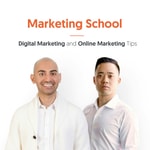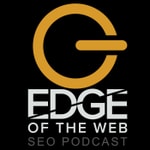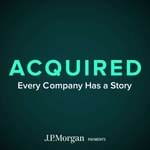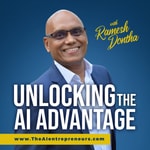Things Have Changed – Détails, épisodes et analyse
Détails du podcast
Informations techniques et générales issues du flux RSS du podcast.
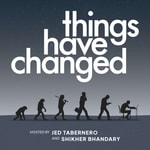
Things Have Changed
Things Have Changed
Fréquence : 1 épisode/10j. Total Éps: 175

Classements récents
Dernières positions dans les classements Apple Podcasts et Spotify.
Apple Podcasts
🇫🇷 France - careers
20/02/2025#78🇫🇷 France - careers
15/11/2024#93🇫🇷 France - careers
08/09/2024#62
Spotify
Aucun classement récent disponible
Liens partagés entre épisodes et podcasts
Liens présents dans les descriptions d'épisodes et autres podcasts les utilisant également.
See all- https://lucy.co/
802 partages
- https://www.headspace.com/
406 partages
- https://www.thc-pod.com/
355 partages
- https://copilot.github.com/
44 partages
Qualité et score du flux RSS
Évaluation technique de la qualité et de la structure du flux RSS.
See allScore global : 58%
Historique des publications
Répartition mensuelle des publications d'épisodes au fil des années.
Unveiling AI's Role in Content Creation with Originality AI's John Gillham
Saison 22 · Épisode 6
lundi 5 août 2024 • Durée 41:33
Have you ever stumbled upon an article or a piece of content online and wondered, "Did someone actually write this, or is it the work of ChatGPT?" In today’s world, where content is produced at an incredible pace, it's becoming increasingly difficult to tell the difference.. and that’s a problem in the age of misinformation.
Think about it: people are getting their news on social media, X, Youtube or Facebook! With the advancements of AI, it’s hard to tell how something online can be truly authentic. With latest studies showing >12% of Google's search results being AI-generated, it's critical to ensure the integrity of the digital content we consume and create.
That's where Originality AI comes in! We’re thrilled to host Jon Gillham, founder and CEO on Things Have Changed. as he shares how his team are tackling these issues head-on by developing cutting-edge tech to detect AI-generated content. In a short span of time, Originality AI have achieved remarkable results, and is the most accurate AI Detector in the market for ChatGPT, GPT-4o, Gemini Pro, Claude 3, Llama 3 etc.
So today on Things Have Changed, we'll dive deep into how Originality AI works, its impact on various industries, and why ensuring content authenticity is more important than ever.
How Cling Systems is Transforming Battery Supply Chains with William Bergh
Saison 22 · Épisode 5
lundi 24 juin 2024 • Durée 47:32
Revolutionizing Battery Recycling: The Future of Sustainable Energy Management
As the world embraces the electric vehicle (EV) revolution, with 1.3 million EVs sold in 2023 alone—a 40% increase from the previous year—the issue of battery disposal and recycling is becoming increasingly critical. The demand for lithium-ion batteries, essential for EVs and other electronics, has skyrocketed, yet the challenge of managing these batteries at the end of their life remains largely unaddressed.
The Circular Economy and Battery Recycling
The concept of a circular economy, where products are reused, recycled, and remade into new products, is gaining traction as a sustainable solution to the growing battery waste problem. Traditional fossil fuels are consumed and discarded, but batteries, composed of valuable materials such as lithium, nickel, and cobalt, present an opportunity for continuous reuse. This shift from a linear to a circular model could significantly reduce the environmental impact of battery disposal.
Cling Systems: Pioneering Circularity
William Bergh, the Founder and CEO of Cling Systems, is at the forefront of this transformation. Cling Systems aims to revolutionize the battery supply chain through closed-loop recycling, ensuring that used batteries are efficiently reclaimed and repurposed. This approach not only reduces landfill waste but also conserves valuable raw materials, contributing to a more sustainable energy future.
Bergh's vision extends beyond recycling. He advocates for urban mining, a process where waste batteries are harvested for their raw materials, effectively replacing traditional mining. This method capitalizes on the fact that batteries, unlike fossil fuels, are not consumed but stored, making their materials available for repeated use.
Challenges and Innovations in Battery Recycling
Despite its potential, the battery recycling industry faces significant hurdles. One major challenge is the lack of standardization in battery design, which complicates the recycling process. Unlike lead-acid batteries, which are standardized and widely recycled, lithium-ion batteries vary greatly in their composition and design. This variability makes it difficult to develop efficient recycling processes that can handle the diverse range of batteries in use today.
Additionally, the supply of end-of-life batteries is highly fragmented. Batteries reach the end of their life in various locations, often ending up in drawers or being exported to different countries. This dispersed supply chain complicates the logistics of collecting and recycling batteries. Cling Systems addresses this challenge by creating a comprehensive database of battery types and conditions, enabling more efficient tracking and management of used batteries.
The Future of Battery Recycling
Looking ahead, the future of battery recycling hinges on continued innovation and collaboration. The industry must scale up recycling processes, standardize battery designs, and develop more efficient logistics systems. As urban mining becomes more prevalent, the reliance on traditional mining for battery materials could diminish, leading to a more sustainable and self-sufficient supply chain.
Bergh envisions a world where the environmental and commercial value of batteries is maximized through seamless recycling and repurposing processes. By removing the costs and complexities of circulating batteries, companies like Cling Systems are paving the way for a greener, more sustainable future. The shift towards a circular economy in battery management not only addresses the immediate waste problem but also suppo
Why Tech Is Going After the Next Trillion Dollar Opportunity - Defense
Saison 22 · Épisode 1
lundi 22 janvier 2024 • Durée 20:01
In the past two decades, technology has dramatically reshaped numerous industries, from newspapers to travel agencies. Once thriving sectors have been disrupted, evidenced by the decline of traditional newspapers, which lost $6 billion in ad revenue to Craigslist alone between 2000 and 2006. Similarly, the rise of platforms like DoorDash, Uber Eats, and Airbnb reflects a significant shift in consumer behavior. Now, this wave of technological disruption is poised to redefine the defense industry, a sector traditionally characterized by unique procurement practices and significant government contracts. 📰📱
The defense sector, once dominated by a handful of major players following a wave of consolidation in the 1990s, is now facing a new challenge: tech-driven transformation. The industry's "cost-plus" methodology, which often leads to inefficiencies and misaligned incentives, is now being scrutinized by tech companies. These new entrants see an opportunity to leverage their expertise in optimizing processes and margins. As tech companies bring their innovative approaches to defense, they're catalyzing a shift towards more efficient and cost-effective solutions. 🚀
Yet, the integration of tech into defense is not without its challenges. Traditional defense contractors are deeply entrenched, familiar with the intricacies of government contracts and regulations. However, companies like SpaceX and Palantir are advocating for more accessible pathways for smaller contractors, potentially leading to greater innovation and competition in the sector. This evolution in the defense industry mirrors the broader impact of tech across various markets, raising questions about the future of defense technology and its implications. 🌐🛰️
How Brands Are Using Tech to Stand Out in Supermarkets – with Erik Chelstad
lundi 10 mai 2021 • Durée 47:41
Product Placement Is Key To Sales And Profit in Supermarkets and grocery stores..
Every aisle of a supermarket has 100s of different brands of products, all vying for your attention and aiming to ultimately end up in your shopping cart.
Getting your product into a new store is hard enough on its own. How do you measure your product availability, inventory levels, product placement or even know what your competition is doing in a store that you do not own?
This data is hugely important for CPG (Consumer Packaged Goods) companies, but has been largely unavailable before.
Our guest today on THC, is aiming to solve this problem with cutting edge image recognition tech!
Today, we have Erik Chelstad, Co-founder and CTO of Observa, a technology company that helps CPG brands understand their customers better through sophisticated data gathering at the brick and mortar stores, using AI to collect data from the pictures, and delivering rich insights to the brand owners.
Their image recognition technology can increase sales force productivity, improve shelf condition insights and help drive incremental sales.
Online Learning Is Here to Stay.. and Schools May Be On Board?
lundi 3 mai 2021 • Durée 29:00
As zoom university comes to an end for the graduating class of 2021, we ask ourselves, is online learning here to stay? The trends say it is... sort of.
Lackluster Investment into Learning Technology
Prior to Covid-19 schools barely invested in online learning with only 5% of their total budget being put towards IT. This applies to the big name universities that have more than 10,000 students in attendance with smaller colleges not investing anything into learning technology. Now after a full year of social distancing shutdowns, colleges have had to rely fully on digital learning and technology to keep classes going and tuition funds flowing.
A New Financial Option
While CPI has increased 236% since 1980, college tuition alone has grown 1200% and that's not even including housing which is an enormous expense for students to pay for. A large reason for this is the branding that top universities have build and the luxury premium that students are willing to get into debt for. The fact that over half of all students are in debt and the total debt sum is now $1.6 Trillion shows how flawed the system currently is. However, thanks to a rise in online learning programs and boot camps there is an alternative to traditional schooling.
Income-Share Agreement Financing
With more and more online learning programs coming to market, the incentive to go to a university are starting to dwindle with some online schools giving students the option to take zero risk in taking their classes. Instead of being put into debt, students have two choices
1. They can choose to pay the upfront cost of programs designed to teach them skills relevant to the specific job they want, or
2. They can pay zero dollars upfront and only have to share a portion (10-15% of their salary typically) if they successfully get hired in a relevant job in a relevant industry that their classes were geared towards.
This option is called an income share agreement and it's been growing in popularity in recent years. Instead of students taking the risk to pay for schooling, the online schools take on the risk that they will provide excellent training that will yield results in the form of getting hired. This incentive makes e-learning companies put their best foot forward when it comes to providing students with a comprehensive and effective learning environment
Future of E-Learning
So with online schools providing students with an alternative, and a large influx of investment into IT, we are going to see a hybrid model of online/ in person learning programs at colleges. Universities are being challenged to prove they're worth $70,000 a year over taking online classes for specialized skills that only get paid if you get hired. It's hard to see universities lowering their tuition or matching this kind of financing structure, but we can expect to see higher quality classes and more online class integrations in the next decades. Combining online classes with in-person classes can allow colleges to scale more students, while still allowing in person learning that is so important for people looking for experiences. If universities don't adapt and prove their value, then prestige may not be enough to keep applications pouring in and tuitions flying higher. There are alternatives now and it's important that applicants consider more than has
How Branding Can Make or Break a Company
lundi 26 avril 2021 • Durée 25:06
Nike, Disney, Coca Cola, Apple, and Sony all have one thing in common. They have built iconic brands that have become recognizable world-wide. Growing up we've been surrounded by brands and they have shaped the way we go about our days, our consumption habits, and our opinions on the best products and services we choose to use. There is an emotional aspect that makes up how we view brands in the present and even more in the future.
So how are brands developed and why are they so important? We live in a global economy where barriers to entry are at historic lows proving that branding is one of the only ways that companies can differentiate from their competitors. Millennials are more demanding of brands that are conscious and aligned with their personal political viewpoints and interests. Statements about donating towards causes or taking steps to become more environmentally conscience goes a long way with consumers today.
An example of how a company is trying to establish brand strength is Chipotle, a food brand, that has built a loyal following even with controversial health issues in the past. Chipotle is focused on providing quality fast casual food, but recently they launched a clothing line, because they understand that this will help strengthen their the loyal customers. By building a brand a business is able to take up more mindshare of people that will use the product/ service more often.
So, there is a shift from Stakeholder capitalism to Shareholder capitalism because investors don't have the same influence over businesses like they once did. The customer now has more power over a businesses focus and approach in what they create and whether they operate in a environmentally conscious way. Social Media has been a catalyst for how consumers have more power in what products perform well. Consumers are realizing that a purchase for product X is a economic vote towards X and by purchasing certain goods and ignoring others they are able to influence brands from their buying patterns.
In the end, branding can make or break a company. It takes decades to build a brand and only one big mistake to cripple a business. Next time your buy new clothes or shop online, remember, your choices actually have a direct impact on how companies are conducting business and you have the ability to influence businesses to align more with what matters to you.
Check out our new brand website and the exciting content that we are bringing every week on THC.
How to Build a Better AI For Your Business – with Hyun Kim
lundi 19 avril 2021 • Durée 55:21
Is it possible to make artificial intelligence more accessible to companies, both large and small?
Our latest episode is with Hyun Kim, Co-Founder and CEO of Superb AI, a company that is building a platform that aims to make shipping AI models easier.
With a highly technical team, that spans 25+ research publications, 7,300 research citations and 100+ patents in computer vision and deep learning technology, Superb AI aims to utilize decades of experience to lower the hurdle for industries to adopt machine-learning technology.
With the rockstar team, SuperbAI uses deep learning AI to label and analyze images and videos up to 10 times faster than manual processes can!
It’s no wonder, their clients include not only small businesses but also Samsung, LG, Qualcomm and Pokémon Go maker Niantic.
With a recent $9.3 million financing round, Hyun and team, are looking to expand further in North America and enter Europe. And we at THC cannot wait for this future to unfold 🚀
How Cloud Kitchens are Making Your Food
lundi 12 avril 2021 • Durée 19:02
How do you know where your UberEats, DoorDash or Caviar orders REALLY come from?
The COVID Delivery Boom
The pandemic has pushed delivery applications to the lime light. The 4 largest food delivery platforms saw their revenues rise $3B collectively in the 2nd and 3rd quarters of 2020. Doordash, who currently operates about 50% of the market, saw 543 million total orders in the first 9 months of the year (compared to about 181 million orders in the same period last year).
Painfully Swallowing the Delivery-app Premium
When the lockdowns happened all over the world, restaurants had to find ways to make money without having "Dine-in" options. Well, they turn to delivery. Restaurant-owners, who dreaded giving away 15-30% of the revenue to the delivery-apps for every order, had to turn to the UberEats and Doordash's of the world.
How do you make money during a Pandemic?
If your only type of sale is delivery, and you're giving away a large part of your revenue to the delivery apps, how exactly do you make a profit? Well, you optimize your costs. Try to make everything cheaper for your operations and expansion. One of the largest costs for any restaurant is the rent! This is where a new industry can help rental costs relatively cheaper: Ghost Kitchens
Kitchens on The Cloud
A Cloud Kitchen or Ghost Kitchen is a large space that can house different types of companies that want to produce products specifically for "take-out". Picture a large warehouse with numerous stations of stainless steel prep tables, hood vents, stoves, ovens, and sinks, each with its own orders coming in direct from customers.
Benefits of a Cloud Kitchen vs Traditional Restaurant Model:
- Low Overhead
- Low Start-up Costs
- Data-Driven Decision Making
- Efficiency
Can E-Learning Translate to Job-Ready Skills? – with Chris Dutton
lundi 5 avril 2021 • Durée 47:57
In a world that's increasingly becoming data-driven, we see the importance of business intelligence or "BI". With more data getting gathered, we have the ability to find key metrics that can simply help us make better decisions.
Today we have a professional that has dedicated his life to helping people get into the field of business intelligence: Chris Dutton, Founder and COO of Maven Analytics, an online business intelligence platform where you can start your journey towards becoming a BI professional. He shares with us the story of how he started with excel!
Excel is just one of the tools that Maven offers courses for, and is where Chris found his passion for teaching. He started out as “The excel guy”.
Chris is now a best-selling instructor on Udemy. This guy has taught about HALF A MILLION students. You can trust he knows what to focus on in the world of online learning. And at Maven, you can learn other BI tools like SQL, PowerBI, and Tableau. What makes it so special, is what Maven really focuses on: Student Outcomes.
The Semiconductor Shortage: How It Will Cost Billions to Solve
lundi 29 mars 2021 • Durée 25:54
In the last episode, or Blitz Talk 31, we talked about how the semiconductor Shortage happened and how important it is to society.
Why can’t we just scale up production and meet demand? Well, we think it might be a supply chain problem. There are only a few players in the manufacturing of chips which means that the supply chains are NOT diverse.
As one use-case, Apple has one supplier for its semiconductor consumption and that is TSMC, or Taiwan Semiconductor Manufacturing Company. It is the worlds largest semiconductor foundry.
With the disruption that the pandemic has provided, we are realizing how important these chips really are. Countries around the world are taking it more seriously and investing more in creating their own supply chains, like China, and recently the United States.
Join us as we parse through the supply problem that chip makers and chip consumers and why the solution might be public-private partnerships.

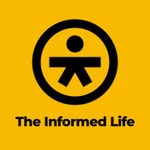


![VideoBourse [Bourse et Trading] VideoBourse [Bourse et Trading]](https://images.mypodcastdata.com/show-images/logo_videobourse-bourse-et-trading-videobourse-1nf2.jpg)
